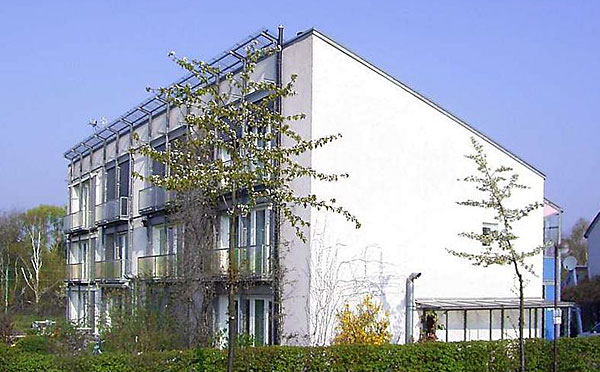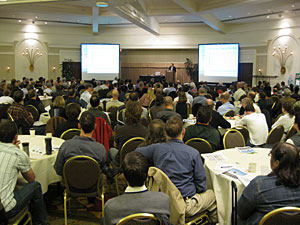 |
| Photo courtesy Wikipedia |
The Original Passivhaus, in Darmstadt, Germany. |

Just a few years ago, the first North American Passive House Conference was attended by a handful of passionate adherents trading tips around folding tables in Urbana, Illinois. But this year, with a keynote speech by green energy prophet Amory Lovins, and attended by roughly 350 practitioners from across the country, the 2010 conference, held from November 4 to 7 in Portland, Oregon, helped establish Passive House as a viable force in the green building movement.
“We’ve gone from 15 certified consultants in 2008 to 200 this year,” says U.S. Passive House Institute’s program director Mike Kernagis. “This is the first conference where we’ve really reaped the benefits of having the consultants come back and show their first projects.”
Passive House — known as Passivhaus in Europe — originated 20 years ago in Darmstadt, Germany, under the stewardship of Wolfgang Feist (another keynote speaker at this month’s U.S. conference). In large part, Fiest synthesized the experiments with passive solar and super-insulated buildings in the 1970s and ‘80s into an organized set of principles for making exceptionally efficient buildings. What distinguishes Passive House certification from programs like LEED is that it’s strictly a performance-based system, with stringent benchmarks in only three areas: air infiltration, Btu consumption, and energy use (in kilowatt hours).
To meet the rigorous Passive House criteria, buildings must be insulated with painstaking care to limit or eliminate areas of thermal bridging. They must also be essentially air tight with an infiltration rate close to 10 times lower than typical energy code allowances. This brings up another catchphrase heard at the conference: heat recovery ventilator (HRV). These heat exchangers are the lungs of a building, as they supply fresh air and lessen the threat of sick building syndrome that plagued early super-insulated projects.
As with other technology-based systems, many Passive House projects initially appeared boxy and engineered rather than designed for aesthetics. But recently, the challenge has been taken up by architects who “think outside the boxy,” as Kernagis puts it. Several architects, such as Parson School of Design’s Laura Briggs, presented projects that are pushing the envelope in both green design and in contemporary design theory.
It’s also significant that the affordable housing organization Habitat for Humanity is building Passive House projects in various locations across the country. Habitat representatives from Vermont, Kentucky, and Washington, D.C., all presented Passive House projects at the conference. Although first costs can be 8 percent to 15 percent higher than standard construction, Habitat’s presence shows the potential of Passive House to meet Habitat’s goal of making housing affordable to operate, as well as to purchase.
When the additional cost is rolled into a 30-year mortgage and balanced against significant energy cost savings, the owners can come out ahead, according to J.B. Clancy, AIA, of Albert, Righter & Tittmann Architects, project manager for a Habitat project in Charlotte, Vermont. “It’s heartbreaking to look back 30 years and see that the U.S. was once the leader in super-insulated buildings,” Clancy says. “But, while we have some catching up to do, the exponential growth of the Passive House movement here is very encouraging.”
With the number of Passive House buildings in Europe exceeding the 17,000 mark, catching up may take some time. But given the growing urgency to address climate change and responsible energy management, this may be an idea whose time has come.


Post a comment to this article
Report Abusive Comment